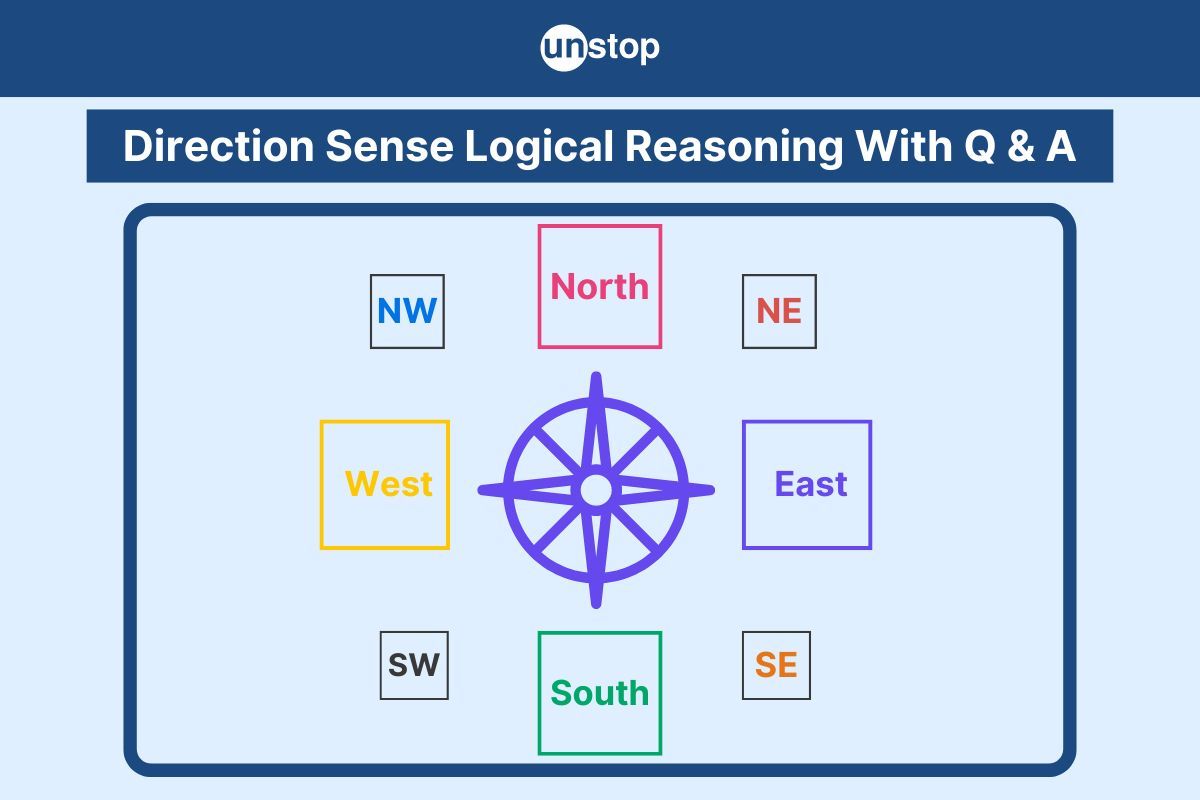- Step 1: The Groundwork
- Step 2: The Three Sections
- Step 3: Practice Makes Improvement
- The Secret Ingredient
- Understanding Basics Of Number Series
- Types Of Number Series Reasoning Questions
- Addition & Multiplication In Number Series
- Square & Cube-Based Number Series Patterns
- Missing Terms & Arranging Sequences
- Tricks & Tips For Solving Number Series
- Selected Number Series Questions With Solutions
- Frequently Asked Questions (FAQs)
- Must Know Terminologies in Blood Relation Questions
- Basic Approaches to Solve Blood Relation Questions
- Types Of Blood Relation Questions
- Tips For Solving Blood Relation Questions
- Multiple Choice Questions (MCQs) with Detailed Explanation
- Conclusion
- Frequently Asked Questions (FAQs)
- Letter Series In Logical Reasoning
- Types Of Letter Series Patterns
- Tips For Solving Letter Series Reasoning
- Best Practice Question Samples With Answers
- Conclusion
- Frequently Asked Questions (FAQs)
- Basics of Problems On Age-Related Questions
- Formula to Solve Problems on Ages-Related Questions
- Types of Age-Related Questions & Examples
- Tips & Tricks for Solving Ages Problems
- Best MCQs on Problems on ages with solved answers
- Conclusion
- Frequently Asked Questions (FAQs)
- Definition of Calendar
- Understanding Days of the Week
- What is a Leap Year?
- Concept of Odd Days in a Century
- Tips For Solving Calendar Reasoning Questions
- Best Calendar Reasoning Questions with Answers (MCQs)
- Frequently Asked Questions (FAQs)
- Basic Concepts of Clock
- Structure of a Clock
- Angle Equilavalence in Clock
- Tips For Solving Clock Questions
- Selected Clock Questions & Answers (MCQs)
- Conclusion
- Frequently Asked Questions (FAQs)
- Understanding The Concept Of Direction Sense
- Tips For Effective Problem-Solving In Direction Sense
- Practical Test Practice Questions And Answers
- Conclusion
- Frequently Asked Questions (FAQs)
- Importance Of Dice Reasoning
- Dice Numbers In Dice Reasoning
- Classification Of Dice
- Constructed Vs Deconstructed Dice
- Tricks & Tips For Solving Dice Problems
- Practice MCQs With Detailed Answers
- Conclusion
- Frequently Asked Questions (FAQs)
- Alphanumeric Series Defined
- Alphanumeric Series In Reasoning Tests
- Tips & Strategies For Solving Alphanumeric Series
- Practice Sample Questions With Detailed Answers
- Conclusion
- Frequently Asked Questions (FAQs)
- Concept Of Mirror Image Reasoning Explained
- Important Terms In Mirror Image Reasoning
- Types Of Mirror Images
- Identifying Correct Mirror Image
- Finding Clock's Mirror Image
- Tips To Solve Mirror Images
- Selected Practice Questions With Answers
- Conclusion
- Frequently Asked Questions (FAQs)
- Concept & Overview Of Input-Output
- Input-Output In Competitive Exams
- Types Of Input-Output Problems
- Strategies, Tips & Tricks For Solving Reasoning Questions
- Selected Practice Questions With Answers
- Conclusion
- Frequently Asked Questions (FAQs)
- Importance Of Finding The Odd One Out
- Tricks And Tips
- How to Find The Odd One Out?
- Solved MCQs with Detailed Explanation
- Conclusion
- Frequently Asked Questions (FAQs)
- Understanding Key Concepts
- Exploring Different Ranking Types
- Formula And Application Of Order And Ranking
- Tips For Solving Order & Ranking
- Selected Practice Questions And Answers
- Conclusion
- Frequently Asked Questions (FAQs)
- Importance Of Pipes & Cistern Aptitude
- Key Terminologies used in Pipes and Cisterns
- Pipes and Cisterns Formula with Examples
- Pipes and Cisterns Shortcut Tricks
- Tips For Solving Pipes & Cistern Problems
- Selected Questions & Answers For Practice (MCQs)
- Conclusion
- Frequently Asked Questions (FAQs)
- Key Concept in Boats and Streams
- Formulas Of Boats & Streams
- Distance & Time Formula
- Tips For Solving Boats & Streams Questions
- Selected Practice Questions With Answers (MCQs)
- Conclusion
- Frequently Asked Questions (FAQs)
- Concept of Mixture and Alligation
- Types Of Alligation Questions
- Formula for Solving Mixture & Alligation
- Tips For Solving Mixture And Alligation
- Selected Questions With Answers For Practice
- Conclusion
- Frequently Asked Questions (FAQs)
- Concepts and Definitions Related to Time and Work
- Important Time And Work Formulas
- Tricks and Tips to Solve Time & Work Questions
- Time And Work MCQs with Detailed Solution
- Conclusion
- Frequently Asked Questions (FAQs)
- What is Harmonic Progression(HP)?
- Formula to find the nth Term in Harmonic Progression
- Formula to find the Sum of the nth Term in HP
- What is Harmonic Mean?
- Harmonic Progression Solved Best MCQs
- Conclusion
- Frequently Asked Questions (FAQs)
- What is Mensuration in Maths?
- What are 2D figures in Mensuration?
- What are 3D figures in Mensuartion?
- Basic Terminologies In Mensuration
- Basic 2D Formulas in Mensuration
- Basic 3D Formulas in Mensuration
- 2D vs 3D in Mensuration
- Solved Questions With Solutions (MCQs)
- Conclusion
- Frequently Asked Questions (FAQs)
- Relationship Between Time, Speed And Distance
- Conversion Units Time, Speed And Distance
- Average & Relative Speed: Two Trains Moving in the same or opposite direction
- Solved MCQs on Time, Speed And Distance
- Conclusion
- Frequently Asked Questions (FAQs)
- What is Simplification in Maths?
- BODMAS Rule in Simplification Explained
- Simplification & Approximation Relation
- Key Terms in Simplification
- Examples Of Simplification Techniques
- Simplification Questions With Solved Answers (MCQs)
- Conclusion
- Frequently Asked Questions (FAQs)
- Height And Distance Important Terms
- Right Angled Triangle In Trigonometry
- Trigonometric Ratios
- Solved Examples For Better Understanding
- Height And Distance Applications In Trigonometry
- Height And Distance Practice Questions & Answers
- Conclusion
- Frequently Asked Questions (FAQs)
- Defining Interest Types
- Simple Interest Vs. Compound Interest
- Selected Solved Questions & Answers
- Conclusion
- Frequently Asked Questions (FAQs)
- Basic Concepts Of Profit And Loss
- Determining Selling Price
- Calculating Discounts
- Formulas For Calculating Profit And Loss
- Examples Of Profit And Loss
- Profit & Loss Questions With Detailed Solution
- Conclusion
- Frequently Asked Questions (FAQs)
- Defining Angle Of Elevation
- Key Terms Used In Angle Of Elevation
- Angle of Elevation Formula with Example
- Angle of Elevation vs. Angle of Depression
- Angle of Elevation MCQs with Answers
- Conclusion
- Frequently Asked Questions (FAQs)
- Defining HCF And LCM
- Calculation Methods Of HCF And LCM
- HCF By Prime Factorization Method
- LCM By Prime Factorization Method
- Difference Between HCF And LCM
- HCF & LCM Practice Questions With Answers
- Conclusion
- Frequently Asked Questions (FAQs)
- What is fraction and decimal?
- Understanding Decimal Fraction
- Place Value in Decimal Fraction
- Mathematical Operations with Decimal Fraction
- Practice with Solved Examples
- Summary
- Frequently Asked Questions
- All About Decimals
- All About Fractions
- How to Convert a Decimal into Fraction
- Simple vs Recurring Decimals
- Converting Recurring Decimals to Fractions
- Conversion Charts
- Practice Questions (With Solutions)
- Closing Thoughts
- Frequently Asked Questions
- What is Arithmetic Mean?
- Arithmetic Mean Formula- Ungroup Data & Group Data
- Merits of Arithmetic Mean
- Demerits of Arithmetic Mean
- Alternatives to Arithmetic Mean
- What is the Weighted Arithmetic Mean?
- Arithmetic vs. Geometric Mean
- Arithmetic Mean Application in Statistical Analysis
- Arithmetic Mean Practice Questions with Explanation
- Frequently Asked Questions
- What is Geometric Progression?
- Key Properties of Geometric Progression
- General Form Of Geometric Progression
- General Term or the Nth Term of Geometric Progression
- The sum of nth Terms of GP
- Types Of Geometric Progression
- Solved Questions and Answers of GP
- Conclusion
- Frequently Asked Questions (FAQs)
- Average in Maths
- Average Formula in Maths
- Differentiating Types of Average
- How to Calculate Average of Negative Numbers?
- Practical Applications of Averages
- Average Questions For Practice
- Frequently Asked Questions
- What is Simple Interest in Maths?
- Simple Interest Formula Explained
- Simple Interest Formula for Years, Months & Days
- Simple Interest Examples & Practice Questions
- Conclusion
- Frequently Asked Questions (FAQs)
- Defining Mathematical Ratios
- Understanding Proportions Fundamentals
- Differentiating Ratios from Proportions
- Ratio and Proportion Formulas
- Properties of Ratio and Proportion
- How to Solve Ratio and Proportion Problems
- Ratio and Proportion Problems (With Solutions)
- Summary
- Frequently Asked Questions
- What is Number in Maths?
- Types of Numbers With Example
- Real vs Complex Numbers Explored
- Basic Operations on Numbers
- Practice Questions (With Solutions)
- Frequently Asked Questions
- What is Arithmetic Progression (AP) in Maths?
- Important Terminologies in Arithmetic Progression
- Basic Terms in Arithmetic Progression
- General Form Of Arithmetic Progression Series
- Types Of Arithmetic Progression
- Solved Questions With Explanation (MCQs)
- Conclusion
- Frequently Asked Questions (FAQs)
- Understanding Basic Concept
- Importance Of Train Problems In Aptitude
- Tips To Solve Train Problems
- Selected Practice Questions & Answers
- Conclusion
- Frequently Asked Questions (FAQs)
- Definition Of Mode
- Calculating Mode For Ungrouped Data
- Calculating Mode For Grouped Data
- Bimodal, Trimodal & Multimodal Distributions
- Comparing Mean, Median & Mode
- Selected Practice Questions With Answers
- Conclusion
- Frequently Asked Questions (FAQs)
- Important Concept In Races And Games
- Calculating Time, Speed & Distance
- Importance Of Races And Games Problems
- Sample Practice Questions With Answers
- Conclusion
- Frequently Asked Questions (FAQs)
- Types Of Partnership
- Formula For Partnership Questions
- Tips To Solve Partnership Aptitude Questions
- Selected Partnership Questions (Practice MCQs)
- Conclusion
- Frequently Asked Questions (FAQs)
Direction Sense: Verbal Reasoning Test Practice Question & Answer

Having a sharp sense of direction is crucial for students preparing for placement interviews and job opportunities. A quick assessment of information related to direction can greatly improve decision-making, problem-solving, and overall awareness in a professional setting.
Cultivating this skill can give students a competitive edge and help them navigate the challenges of the job market with confidence.
Understanding The Concept Of Direction Sense
To begin with, let us understand the concept of direction sense in detail:
What Are Cardinal Directions
The cardinal directions are the four main points on a compass that indicate north, south, east, and west. North is towards the top of the map, south is towards the bottom, east is to the right, and west is to the left.

Understanding the cardinal directions is crucial for reading maps, following directions, and finding our way in unfamiliar places. By mastering cardinal directions, students can confidently approach exam questions that involve spatial awareness and critical thinking.
Additionally, using cardinal directions effectively can help students navigate complex study materials and organize information logically. A solid grasp of cardinal directions is essential for students looking to excel in exams that test their spatial reasoning and analytical skills.

Tips For Effective Problem-Solving In Direction Sense
Let us study some tips to solve direction sense questions effectively:
Systematic Approaches
When tackling direction sense problems, utilize systematic approaches to ensure a structured solution process. Begin by carefully analyzing the information provided in the problem statement.
By approaching each detail methodically, you can avoid confusion and arrive at the correct answer efficiently.
Visualization Techniques
Enhance your problem-solving skills by incorporating visualization techniques. Visualizing the given directions on a map or diagram can significantly aid in understanding complex spatial relationships.
This approach helps in clarifying the problem and enables you to navigate through different directions with ease.
Simplifying Complex Problems
To tackle challenging direction sense problems, focus on simplifying complex scenarios into manageable steps. Start by identifying key landmarks or reference points that can guide your understanding of directions.
By breaking down intricate problems into simpler components, you can approach each step systematically and derive the correct solution.
Regular Practice
Boost your confidence by practising regularly with various direction sense problems. Familiarize yourself with different scenarios involving cities, landmarks, distances, and directions.
Develop a strategy that works best for you, whether starting from a known point or working backwards from the destination.
Common Patterns
Familiarize yourself with common patterns in verbal reasoning questions related to direction sense. Identify recurring themes such as left-right orientation, compass directions, and distance calculations.
Click here to enhance and upskill your knowledge related to various logical reasoning, including direction sense.
Practical Test Practice Questions And Answers
Practice is key to mastering problems and questions related to direction sense! Provided below are some selected questions with detailed answers:

Question 1: What is the term for the angle measured clockwise from true north to a given direction?
a) Inclination
b) Elevation
c) Bearing
d) Azimuth
Answer: d) Azimuth
Explanation: Azimuth is the angular measurement in a spherical coordinate system.
Question 2: In a journey, a man starts walking towards the sun and after some time he turns to his right. After some more time, he turns to his right again. Now which direction is he facing?
a) South
b) North
c) East
d) West
Answer: d) West
Explanation: Initially, he was walking towards the west, so after two right turns, he would be facing west.
Question 3: A person starts from point A, walks 6 km north, turns left and walks 4 km, turns left again and walks 6 km, and then turns right and walks 6 km. How many km is he from the starting point?
a) 8 km
b) 9 km
c) 10 km
d) 11 km
Answer: c) 10 km
Explanation: The man is 10 km towards the west.
Question 4: If a man facing north turns 135 degrees in the clockwise direction and then 180 degrees in the anticlockwise direction, in which direction is he facing now?
a) Northwest
b) Southeast
c) Northeast
d) Southwest
Answer: a) Northwest
Explanation: The man faces the southwest direction after the given turns.
Question 5: A person starts walking towards the East. After walking 10 meters, he turns to his left and walks 10 meters. Then he turns to his left again and walks 10 meters. How far is he from his starting point, and in which direction?
a) 10 meters, East
b) 10 meters, North
c) 10 meters, South
c) 20 meters, South
Answer: b) 10 meters, North
Explanation: The person ends up 10 meters north of his starting point.
Question 6: If a person walks 5 km towards the north, then turns to the right and walks 10 km, how far is he from his starting point?
a) 5 km
b) 10 km
c) 10√2 km
d) 5√2 km
Answer: c) 10√2 km
Explanation: The person ends up 10 km east and 5 km north of his starting point, forming a right-angled triangle.
Question 7: A person goes 10 meters in the west direction from his house, then turns to the right and goes 10 meters, then turns left and goes 10 meters, and then turns to the left again and goes 10 meters. Where is he now with respect to his house?
a) East
b) West
c) South
d) Northeast
Answer: b) West
Explanation: The person ends up 10 meters west of his starting point.
Question 8: If you walk from point A to point B, then to point C, then to point D, and finally back to point A, what is your direction with respect to point A?
a) Opposite
b) Same
c) West
d) North
Answer: b) Same
Explanation: You end up back where you started, so the direction is the same.
Question 9: A person starts from point A and walks 8 km towards the east. Then, he turns to his left and walks 5 km. After that, he turns to his left again and walks 8 km. Finally, he turns to his right and walks 5 km. What is his final direction from point A?
a) West
b) North
c) South
d) Northeast
Answer: b) North
Explanation: After the series of turns, the person faces west from point A.
Question 10: A person walks 3 km towards the north, then turns right and walks 4 km, and then turns left and walks 5 km. Finally, he turns to his left again and walks 4 km. What is his final direction with respect to his starting point?
a) South
b) North
c) West
d) Southeast
Answer: b) North
Explanation: After the series of turns, the person is facing south with respect to his starting point.
Conclusion
Mastering direction sense is essential for excelling in verbal reasoning tests. You can significantly enhance your skills by understanding the concept, learning its importance, and applying effective problem-solving techniques.
Utilizing tips and practical exercises, you can confidently tackle direction-sense problems. Remember, consistent practice and utilizing diverse problem-solving approaches will solidify your grasp of direction sense.
Quiz Time To Test Your Mind
Frequently Asked Questions (FAQs)
1. What is the importance of understanding the direction sense concept?
Understanding direction sense is crucial for various life aspects, from navigating new places to solving problems efficiently. It enhances spatial awareness, improves decision-making skills, and boosts logical thinking abilities.
2. What is the concept of direction?
The concept of direction refers to the direction towards which something is moving or pointing. In a physical sense, direction can be described in terms of north, south, east, and west, as well as up, down, left, and right.
3. How can mastering direction sense benefit my problem-solving skills?
Mastering direction sense enables you to approach problem-solving tasks with a structured mindset, leading to quicker and more accurate solutions. It enhances your analytical skills, promotes critical thinking, and improves cognitive abilities.
4. Are there effective problem-solving techniques specifically tailored for direction-sense problems?
Yes, specialised techniques include visualization, creating mental maps, using directional cues, and breaking down complex problems into simpler steps. These strategies help in approaching direction-sense problems systematically and arriving at solutions with ease.
5. How can practical test practice exercises help enhance my sense of direction?
Regular practice exercises reinforce your understanding of direction-sense concepts and improve your speed and accuracy in solving related problems. Engaging in hands-on exercises can sharpen your skills and build confidence in tackling diverse scenarios.
Suggested reads:
- Data Interpretation: Definition, Steps, & Practice Questions
- What Is Number In Maths: History, Types, Operations & More
- Ratio and Proportion: Mastering Fundamentals (+ Solved Questions)
- Arithmetic Progression- Notation, Formulas, Questions And Answers
- Geometric Progression- Definition, Formula, Questions & Answers
Instinctively, I fall for nature, music, humor, reading, writing, listening, traveling, observing, learning, unlearning, friendship, exercise, etc., all these from the cradle to the grave- that's ME! It's my irrefutable belief in the uniqueness of all. I'll vehemently defend your right to be your best while I expect the same from you!
Login to continue reading
And access exclusive content, personalized recommendations, and career-boosting opportunities.
Subscribe
to our newsletter
















Comments
Add comment